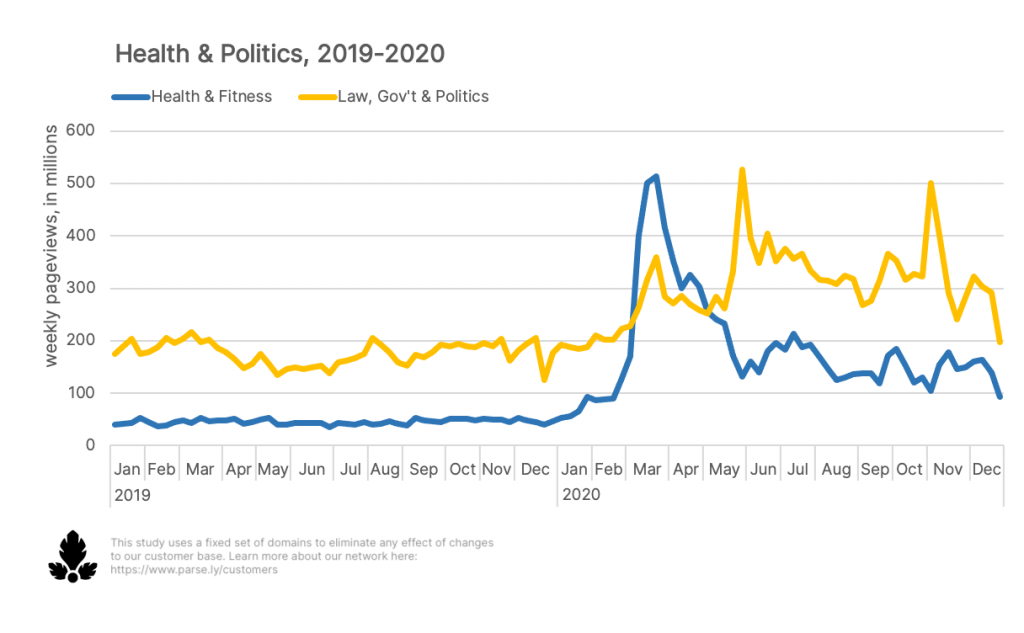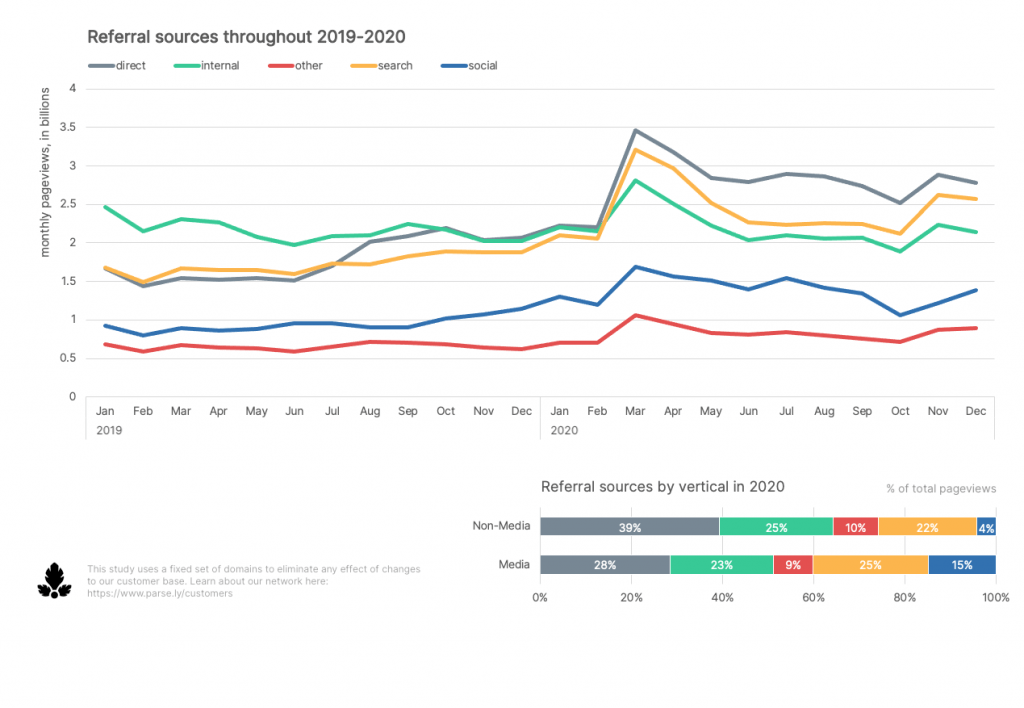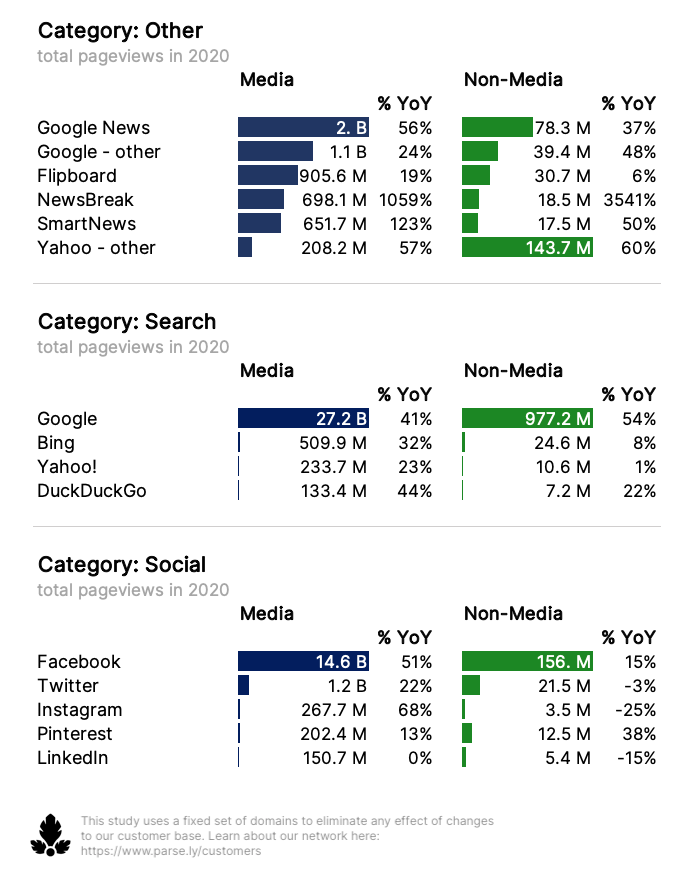How 2020 Impacted the Content Landscape and What that Means for Content Creators

The events of 2020 certainly had a profound impact on all of our lives on a professional, political, and personal level. Not surprisingly, those experiences resulted in significant shifts in our content consumption habits throughout the year. Parse.ly’s lead data analyst, Kelsey Arendt, collected and analyzed 2020 content data from our network of 4,000+ sites and put together a comprehensive data study detailing the trends she found. This blog post will provide a brief summary of her findings and what they mean for your 2021 content strategy.
Table of Contents
- “Politics” and “Health” Blew Up
- Top Categories 2019-2020
- Referral Sources 2019-2020
- Pre-2020 Trends Holding Constant
“Politics” and “Health” Blew Up
The most significant shifts in the content landscape last year started around March with the COVID-19 outbreak. With the pandemic came a host of new challenges for all of us around staying healthy, and the internet responded by creating TONS of new content. Looking for expertise and guidance during those uncertain times and as they were adjusting to the new normal, audiences turned their attention to things like work from home best practices, maintaining good mental health, and developing pandemic-safe fitness routines. As a result, Health & Fitness content saw a whopping 307% more attention in 2020 than it did in 2019.

The other major shift in audience attention Arendt saw last year happened in the politics category and started around the same time. Important issues like the U.S. election, Joe Biden’s campaign, the murder of George Floyd, Brexit, healthcare concerns, police reform, and unemployment drove attention for content in the politics category up 70% from the year before.
Top Categories 2019-2020
“Health” and “Politics” weren’t the only categories to experience increases in consumption and production last year. In fact, all but one of our top 20 content categories saw at least some growth. Some other notable attention spikes that happened in March 2020 were in the “Shopping” and “Food + Drink” categories (421% and 101% month over month respectively) due to in-person shopping/dining options being off the table, and in the “Science” and “News” categories (166% and 126% MoM) due to social-distancing and COVID-19 being front and center.

Aside from these major event-based spikes in attention, Arendt also identified the content categories that not only garnered significant attention last year but also show signs that they will remain relevant in years to come. These include “Arts + Entertainment,” “Automotive,” “Careers + Education,” “Family + Parenting,” “Food + Drink,” “Science,” “Style+Fashion,” and “Tech.”
Organizations who create content in these categories experienced major spikes in attention starting around March and used that as a springboard to ramp up their production. As more people adjust to the new normal and lean into learning new skill sets or exploring their interests, they’ll be looking for more content in these categories for guidance.
Content from the “Business,” “News,” “Shopping,” “Sports,” and “Travel” categories also benefited from the initial attention spikes of 2020 but have since plateaued. This type of content is still in high demand, however, and its audience grew significantly last year.
The biggest takeaway from all of the category data is that organizations should lean into creating content that helps people adjust to the new normal, rather than just the big news stories.
Referral Sources 2019-2020
Arendt also looked at the trends in traffic referral sources across our network and found that nearly every referral platform saw a hike in traffic March 2020. This means that media and non-media organizations alike saw an increase in the percentage of total pageviews per referral source compared to last year.

Search referrals increased from 2019, grew steadily throughout the year, and are continuing to grow now. More people than ever are doing their own research and looking for reputable content, so understanding search referral traffic and bolstering SEO should be top of mind for content teams going forward.
Even more people are sharing content through dark sources (email, messaging, apps), which is why we saw direct referrals also grow substantially and actually surpass search last year, making it the top referral source for 2020.
Social referrals, on the other hand, declined throughout the year, but it’s worth noting that content from media companies, however, saw 3.75 times more traffic from social platforms than content from brands did.

The “Other” category above refers to content aggregators, like Google, News Break, Flipboard, and SmartNews. Arendt found that non-Google, niche aggregators saw significant growth in 2020 which is likely because audiences are looking more and more for focus and personalization. Making niche aggregator distribution part of your content strategy should be top of mind for every content team in 2021.
Some Pre-2020 Trends Are Holding Constant
Despite all of the major shifts mentioned above, there were a few reader habits thatArendt noticed that did not change at all throughout last year. Mobile still dominates desktop consumption 2:1 because well…we’re all constantly on our phones. Keep mobile top-of-mind this year, and make sure you’re catering to that type of consumption.
Consistent with 2019, Google and Facebook continue to dominate the search and social worlds. Finally, Arendt looked at the average audience attention throughout the day during 2020 and found that there isn’t exactly a “perfect” time of day to publish your content. What really matters is understanding who your audience is and where they live so you can publish content when they are awake – makes sense.
If you’d like to dive deeper into any of Arendt’s findings and learn more about what they mean for your team’s 2021 content strategy, take a look at the full data study as well as the Q&A webinar she held a few days ago. As always, we’re here for any questions you have and are always happy to chat about how to overcome the challenges you’re facing with content strategy.